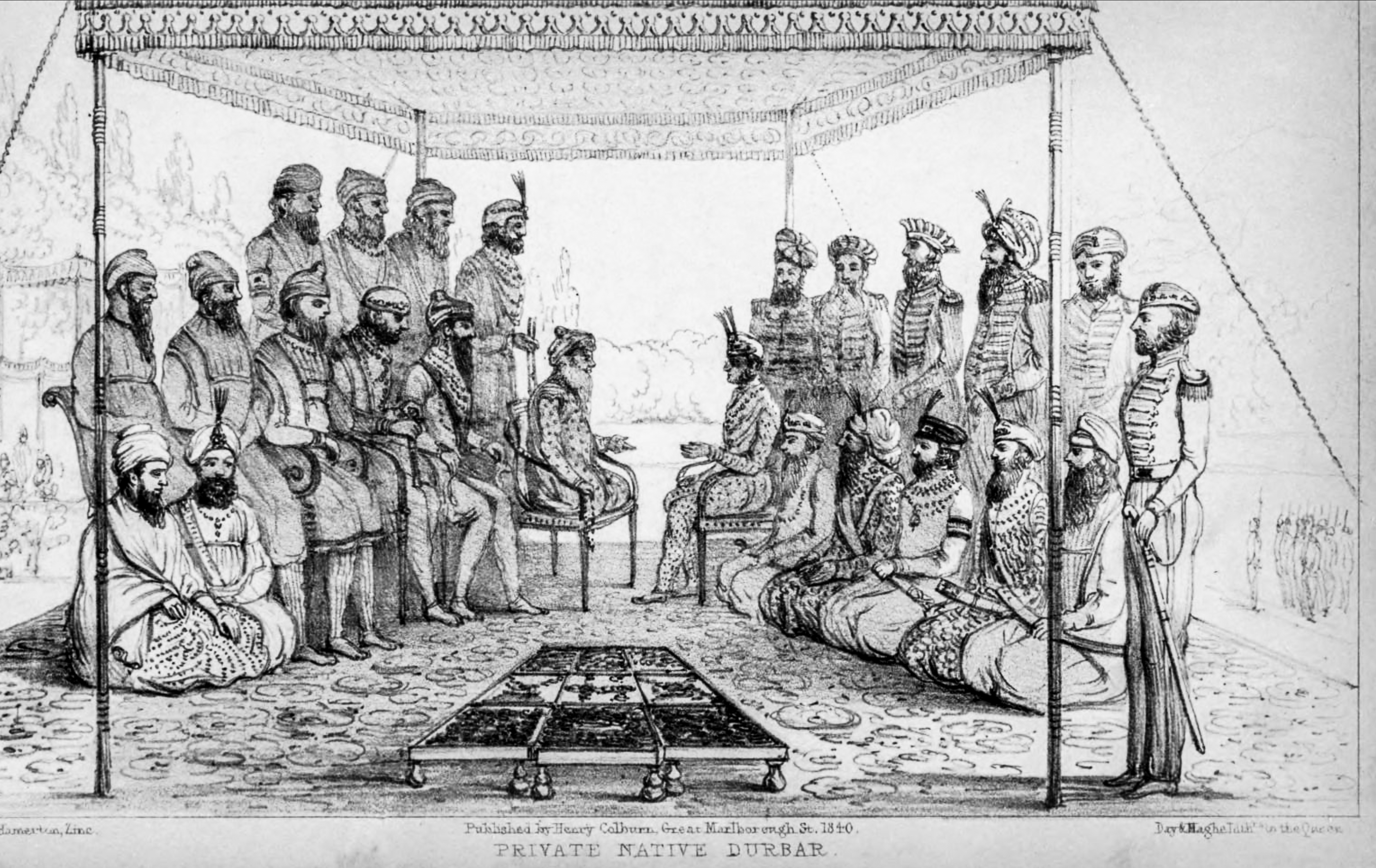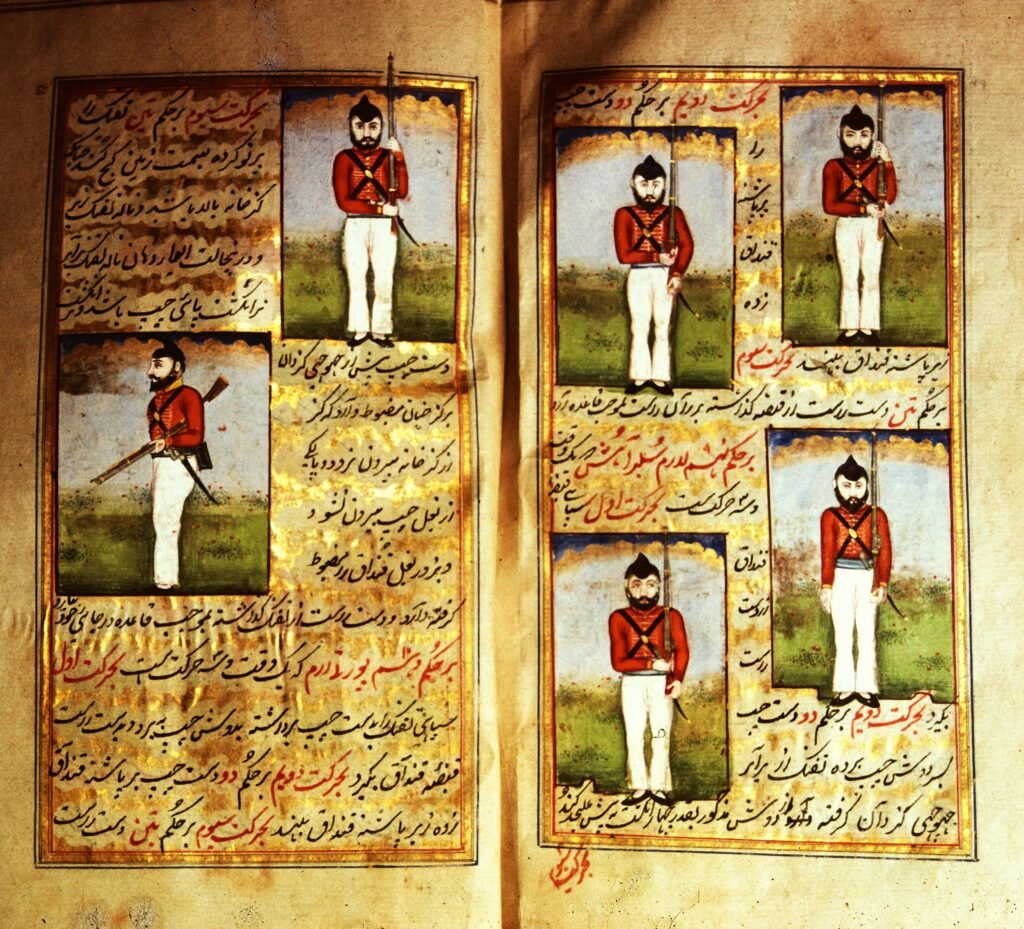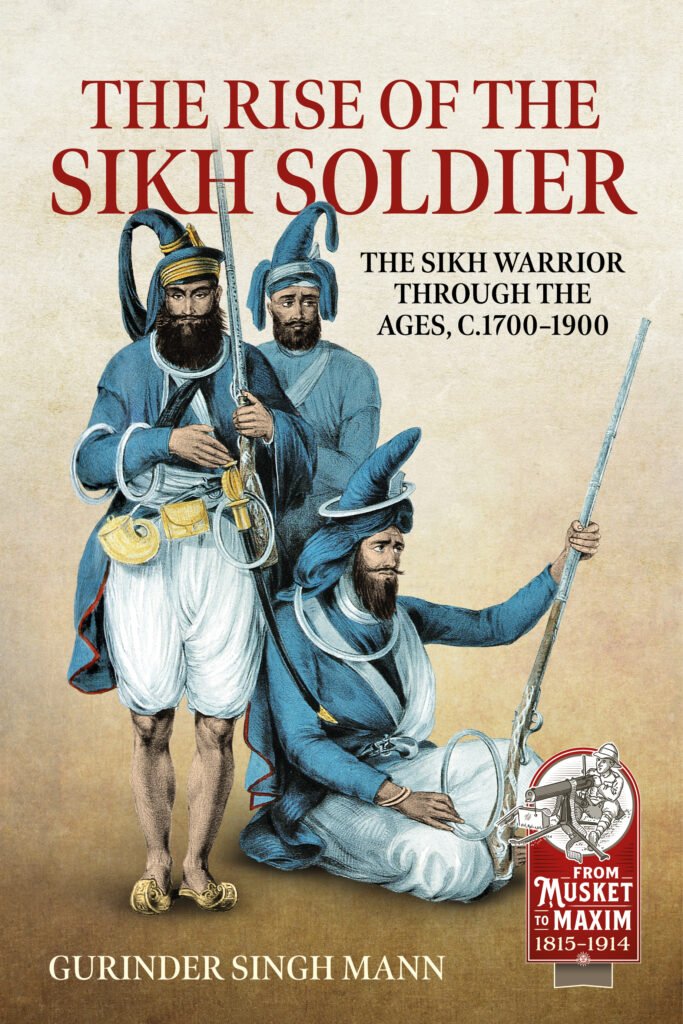
Ranjit Singh and his courtiers (left), the Ferengi contingent (right). G.W. Osbourne, The Court and Camp of Runjeet Singh (London: Henry Colburn, Publisher, 1840).
By Author Gurinder Singh Mann tieing into his book The Rise of the Sikh Soldier
The Sikh army had developed through various centuries and in the eighteenth century had proved its mettle under strong leaders like Jassa Singh Ahluwalia (1718 – 1783) and the development of the Sikh Confederacy or Misls. The fight for survival in the Panjab of the Sikh faith and subsequent conquests around Hindustan showed the warriors of Guru Gobind Singh were equipped to deal with larger and more powerful armies. The Afghan contingents which had desecrated large parts of India under Ahmed Shah Abdali (c.1722-1772) were sent marching back to Kabul. The once mighty Mughal Empire was vanquished in 1783 under the military leader and statesman Baghel Singh of the Karorasinghia Misl leading to taxation rights with the Mahrattas, Rohillas, and left the East India Company (EIC) watching in awe. Female leaders also played their part wielding the Khalsa axe, with notable woman like Sahib Kaur (1771–1801) of Patiala and Sada Kaur (1762–1832) of the Kanhaiya Misl demonstrating their military prowess.
The Sikhs reliance on cavalry as their primary mode of battle exposed their need for better military tactics and improvement in weaponry. With the advent of Maharajah Ranjit Singh’s Sikh Empire there was a movement towards the greater employment of infantry and artillery. Whilst researching for the book, I consulted the Khalsa Durbar Records (KDR), some of which had been compiled a century earlier. Initially, Purbias, a small number of deserters from the EIC, as well as Sikhs formed this branch. Examining the payrolls of the KDR from 1813 the bulk of the infantry consisted of Hindustanis, Gurkhas, and Afghans. This changed by the year 1818 when the Sikh recruitment expanded amongst this branch and became predominant. In a similar manner the main recruits were Purbias and Muslims to the artillery. The Sikhs took to and adopted the new measures relatively easily, and the introduction of matchlocks proved popular.
Ranjit Singh still felt the need of various military improvements within the empire. At the same time the reports of his conquests were now becoming known throughout the world. This led to many Europeans looking for employment in his every expanding Panjab. In 1822, after passing various tests and providing letters, Generals Jean-Francois Allard (1785–1839) and Jean-Baptiste Ventura (1794–1858) entered the service of the Sikh Empire. In 1827 there was the employment of Claude Auguste Court (1793–1880), and then Paolo Di Avitabile (1791–1850). Overall, there was in excess of 60 foreigners, or Ferengi, who would provide military service for Ranjit Singh. This resulted in a host of various military innovations including the raising of regiments of Dragoons, improvements in cannon technology, the import of weaponry (cuirass and guns) from France, and overall improvements in the drills of the soldiers. Allard and Ventura had military manuals translated from French into Persian and commands were ushered in French also. A tri-colour flag added to these changes together with the adoption of European uniforms.
By 1825, the Fauj-i-Khas (infantry, cavalry, and artillery) based in Anarkali, Lahore had reached the number of between 5,000-6,000 strong. This elite force of soldiers became pivotal in many campaigns at Peshawar, Derajat, quelling the jihad of Sayyid Ahmad Barelvi (1786–1831), and securing the border of Jamrud. The elite force was also responsible for the Anglo-Sikh border along the Sutlej, and the Fauj-i-Khas undertook patrols from the Himalayas down to Hari-ka-Pattan. This was an important job ensuring border security, not only from infringement by the Akali Nihangs but also from the threat of the British.
One of the important aspects which came out whilst writing the book was the genius of Maharajah Ranjit Singh with regards to how he absorbed their service into the burgeoning Sikh Empire and, if anything, the innovations of military expertise were synthesised with the traditional Sikh soldiery from the Misl period. This is why the old methods of warfare were not dispensed with and instead the European trained units were added on. The notable hardened Sikh warriors like Akali Phula Singh (1761 –1823) and Hari Singh Nalwa (1791–1837) were synonymous with the major conquests around the Afghan regions. Military and technological innovations by Lehna Singh Majithia (d.1854) surprised the Europeans. Yet the disciplined system of the Ferengi proved pivotal in many campaigns in which they all participated.

Military drill from The Military Manual of Maharajah Ranjit Singh. (1822-30). Maharajah Ranjit Singh Museum, Amritsar: Acc.No:1035. Photo courtesy of Jean Marie Lafont.
After the death of Ranjit Singh in 1839, and the army imploding, most Europeans left the service of the empire, yet their tactics were still deployed, often to the surprise of their adversaries. The Fauj-I-Khas general Shaikh Basawan was praised when he unfurled the Khalsa Flag in Kabul whilst supporting the EIC in restoring Shah Shuja to the throne in 1839. More importantly the European drills and infantry and artillery innovations proved their worth in the Anglo Sikh Wars of 1845-1846 and 1848-1849. With a handful of Europeans remaining the Sikh tactics of defence and using their guns effectively gave a bloody nose to the EIC but the treacherous miliary leadership exhibited during this time let the Sikh Empire down.
To this day the contribution of the Ferengi is recognised all round the world not just by the Sikhs but also by the descendants of the European soldiers. In 2016 Maharajah Ranjit Singh’s Fauj-i-Khas received renewed recognition in the fashionable resort of St Tropez on the French Riviera. A bust of Maharajah Ranjit Singh, General Allard, and his wife Pan Dei was unveiled. This was undertaken by the great-grandson of Allard, Henri Prevost-Allard, the Mayor of the City.
The Rise of the Sikh Soldier is available from Helion and Company.


